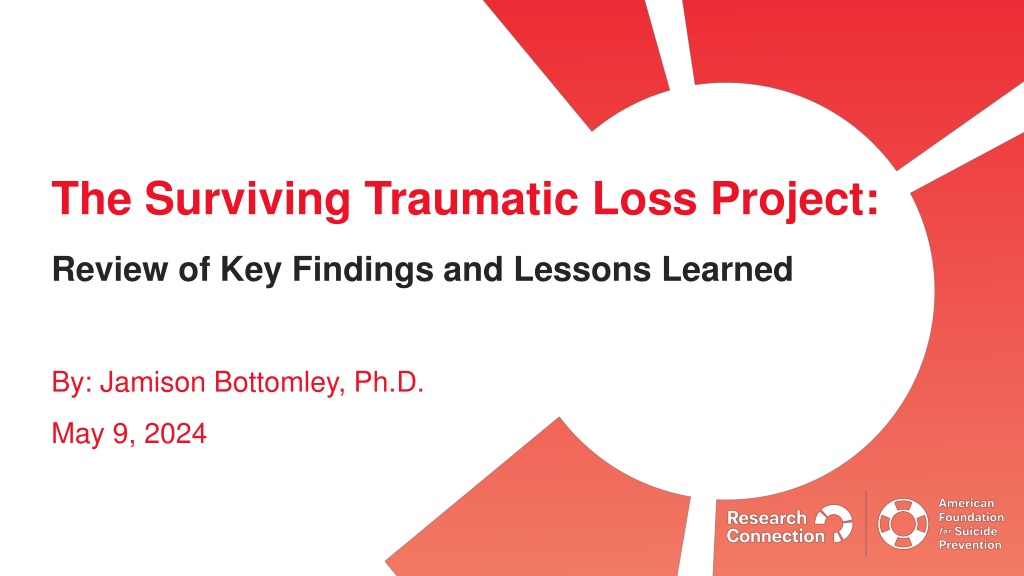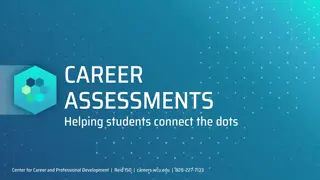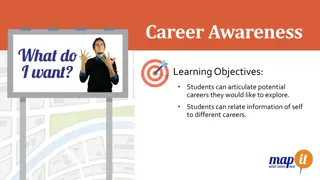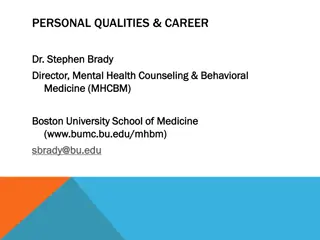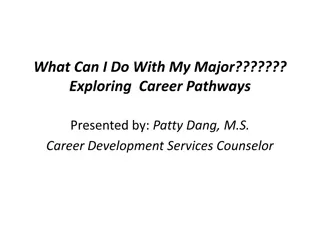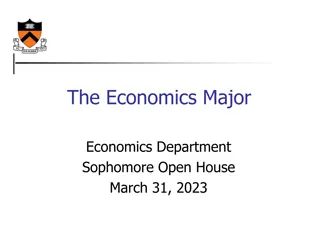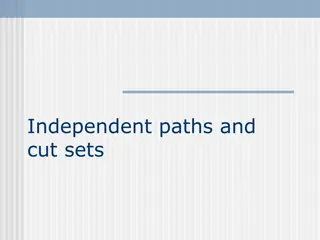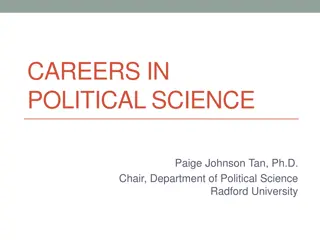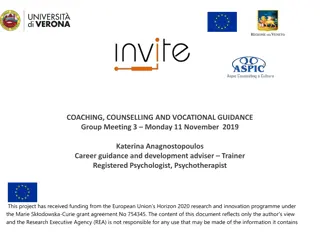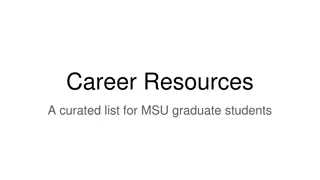Your Major and Future Career Paths
In today's evolving job market, your college major may not dictate your professional success as much as your work ethic and attitude. Research shows that individuals with unrelated majors can achieve equal success in various fields. As the workforce changes due to digitalization and emerging technologies, having a degree will be more of a prerequisite than a career-defining factor. The future may require multiple career changes, as even high-skilled professions are at risk of automation. Prepare for a dynamic job landscape by focusing on adaptability and continuous learning.
Download Presentation

Please find below an Image/Link to download the presentation.
The content on the website is provided AS IS for your information and personal use only. It may not be sold, licensed, or shared on other websites without obtaining consent from the author.If you encounter any issues during the download, it is possible that the publisher has removed the file from their server.
You are allowed to download the files provided on this website for personal or commercial use, subject to the condition that they are used lawfully. All files are the property of their respective owners.
The content on the website is provided AS IS for your information and personal use only. It may not be sold, licensed, or shared on other websites without obtaining consent from the author.
E N D
Presentation Transcript
The Surviving Traumatic Loss Project: Review of Key Findings and Lessons Learned By: Jamison Bottomley, Ph.D. May 9, 2024
Outline: 1. Suicide and Overdose Loss 2. The Surviving Traumatic Loss (STL) Project 3. Selected Findings a. Mental Health Outcomes b. Bereavement-related Needs c. Conclusions d. Future directions 4. Lessons Learned
SUICIDE AND OVERDOSE LOSS Prevalence of Suicide and Overdose Loss Magnitude of suicide and OD deaths are considerable Prevalence of suicide and OD bereavement: 135 people exposed to each suicide death1 About half report being personally affected2 Two in five US adults experience OD loss3 4.2% of the population significant of devastating effect that I still feel 3 1Cerel et al., 2018; 2Cerel et al., 2013; 3Athey et al., 2024
SUICIDE AND OVERDOSE LOSS Suicide and OD Loss: MH Correlates Suicide Loss: Vulnerability: PTSD1, PGD2, Depression1, Risky Substance Use/SUD3, Suicide4 Overdose Loss: Vulnerability: Largely unknown Shared themes with suicide loss: stigma, guilt, shame, human volition (intentionality gradient), sudden or violent qualities 1Bottomley et al., 2022; 2Djelantik et al., 2020; 3Pitman et al., 2020; 4Molina et al., 2019
THE STL PROJECT The Surviving Traumatic Loss Project To develop information on: The distinctions and commonalities between suicide and OD loss Challenges among a growing and vulnerable group Many of whom have heightened risk for suicide To understand what helps survivors most as they recover
THE STL PROJECT Study Aims 1. To compare/contrast suicide and OD loss a. Mental health & suicide risk b. Thematic elements c. Coping strategies and support utilization 2. To understand bereavement-related needs a. Similarities and distinctions 3. To understand how needs, support, and outcomes relate over time
THE STL PROJECT Design, Development, & Implementation 12-month (T3) 6-month (T2) Baseline (T1) Online, longitudinal survey design Informed by CBPR approach Produced needs assessment instrument Informed development of longitudinal survey and incentive structure Employed comparison group of sudden-bereaved adults Obtained support from AFSP in late 2018
THE STL PROJECT Design, Development, & Implementation Measures at each timepoint Baseline (T1) 12-month (T2) 6-month (T2) Demographics Loss Characteristics PGD, PTSD, Dep sx Suicide Risk Needs Support Utilization Coping Strategies Grief themes PGD, PTSD, Dep sx Suicide Risk Needs Support Utilization Coping Strategies Grief themes PGD, PTSD, Dep sx Suicide Risk Needs Support Utilization Coping Strategies Grief themes
THE STL PROJECT Sample Data collection began in 2019* Baseline (T1): N = 403 adults bereaved by traumatic loss Mage= 42.31 (17.17) MTSL = 25.12 (18.09) months Gender: 84.1% female (n = 339) Race: 71.0% White (n = 286) Suicide Loss (n = 185) Overdose Loss (n = 115) Sudden-Natural (n = 103) Retention rates: 68-74% *Experienced setbacks early that required multiple starts and stops on recruitment
SELECTED FINDINGS: MH OUTCOMES Mental Health Among OD and Suicide Loss KEY TAKEAWAY #1 OD and SL: Significantly higher rates of PGD, PTSD, and Depression relative to SN 2 (2, N = 346) = 48.89, p < .001 2 (2, N = 351) = 23.04, p < .001 2 (2, N = 403) = 13.72, p = .001 74.5 74 54.1 52.2 51.3 43 42.2 No sig. differences between OD and SL for PGD, PTSD, and Depression 35.7 35.6 32 32 31.3 22.6 21.1 20.4 SL experienced elevations in anxiety and suicide risk PGD PTSD Depression Anxiety Suicide Risk Overdose Suicide Loss Sudden Natural Bottomley et al., 2022
SELECTED FINDINGS: MH OUTCOMES Mental Health Among OD and Suicide Loss KEY TAKEAWAYS #2 B SE OR 95% CI p Adults bereaved by suicide or overdose were 2.3-3.8x PGD Dx as likely to meet criteria for PGD, PTSD, or MDD Gender (F) -0.05 0.33 0.95 [0.49, 1.81] .875 Respondent Age 0.01 0.01 1.01 [0.98, 1.02] .761 compared to SNL Ethnicity (W) 0.14 0.29 1.14 [0.64, 2.06] .645 # R Psy Dx 0.19 0.11 1.21 [0.98, 1.48] .073 TSL -0.01 0.01 0.99 [0.98, 1.01] .518 Closeness 0.04 0.02 1.04 [0.99, 1.09] .082 Nuclear Family 1.26 0.31 3.50 [1.89, 6.47] <.001 COVID-19 0.38 0.36 1.47 [0.73, 2.95] .281 Suicide Loss 1.01 0.33 2.74 [1.44, 5.19] .002 Overdose Loss 1.03 0.37 2.79 [1.36, 5.74] .005 Bottomley et al., 2022
SELECTED FINDINGS: NEEDS The Sudden-Bereavement Needs Inventory (SBNI) Based on CBPR approach Six need categories The Sudden Bereavement Needs Inventory (SBNI) (Bottomley & Smigelsky, 2022) Instructions: Below you will find a generic list of grief-specific needs that individuals bereaved by the death of a loved one commonly express. We would like to know the role these needs play in your life at this current time. Please read each statement and select the response to indicate how important this need is to you. Not at all important Somewhat important Moderately important Very important Extremely important 1. To eat well 1 2 3 4 5 2. To sleep well 1 2 3 4 5 3. To exercise regularly 1 2 3 4 5 1. Pragmatic Needs To sleep well 2. Informational Needs To better understand the grief journey 3. Spiritual Needs To have an ongoing connection with God 4. Relational Needs To be with those who experienced similar loss 5. Meaning Needs To make sense of the loss 6. Emotional Needs To be emotionally supported 4. To successfully complete the task(s) of the day 1 2 3 4 5 5. To maintain financial balance 6. To receive valuable information and/or advice from professionals 7. To be walked through/introduced to various support resources 1 2 3 4 5 1 2 3 4 5 1 2 3 4 5 8. To better understand the grief journey following this type of loss 1 2 3 4 5 9. To have time to reflect on life 1 2 3 4 5 10. To have an ongoing connection with God 1 2 3 4 5 11. To have an ongoing connection with my spiritual self 1 2 3 4 5 12. To be with those who experienced a similar loss 13. To receive valuable information and/or advice from others who have experienced a similar loss 14. To express my thoughts and feelings regarding the loss with those who experienced a similar loss 15. To find some sort of benefit in the loss 1 2 3 4 5 1 2 3 4 5 1 2 3 4 5 1 2 3 4 5 16. To make sense of the loss 1 2 3 4 5 17. To understand who I am after the loss 18. To express my thoughts and feelings about the loss with those I love 19. To have my grief witnessed (acknowledged, respected, appreciated) by others 20. To be emotionally supported 1 2 3 4 5 Good psychometric properties 1 2 3 4 5 1 2 3 4 5 1 2 3 4 5 Internal reliability, concurrent validity, discriminant validity All items should be summed within their respective factor. Factor: 1. Pragmatic Needs 2. Informational Needs 3. Spiritual Needs 4. Relational Needs 5. Meaning Needs 6. Emotional Needs Citation: Bottomley, J. S., & Smigelsky, M. A.. (2022). Bereavement in the Aftermath of Suicide, Overdose, and Sudden-Natural Death: Evaluating a New Measure of Needs. Assessment, 107319112210811. https://doi.org/10.1177/1073191122108113 9 Items: 1, 2, 3, 4, 5 6, 7, 8 9, 10, 11 12, 13, 14 15, 16, 17 18, 19, 20 Bottomley & Smigelsky, 2022
SELECTED FINDINGS: NEEDS Latent Class Analysis of Need Profiles Person-centered analysis to understand relation between needs and outcomes 4-class solution best fit data Low Needs (LN) Moderate Needs Spiritual (MNS) Moderate Needs Relational (MNR) High Needs (HN) Bottomley, Campbell, & Neimeyer, 2022
SELECTED FINDINGS: NEEDS Latent Class Analysis of Need Profiles Bottomley, Campbell, & Neimeyer, 2022
SELECTED FINDINGS: NEEDS Latent Class Analysis of Need Profiles KEY TAKEAWAYS 1. High needs class comprised of elevated and impairing MH sx 2. High needs class mostly comprised of suicide and overdose loss 3. Evidence suggesting possibility of similar needs across suicide and OD loss Bottomley, Campbell, & Neimeyer, 2022
SELECTED FINDINGS: NEEDS Direct Comparison of Needs and Mental Health Aim 1: Following the 2022 LCA directly compare needs across loss Bottomley, Smigelsky, Campbell, Neimeyer, & Rheingold, in press
SELECTED FINDINGS: NEEDS Direct Comparison of Needs and Mental Health Aim 1: Following the 2022 LCA directly compare needs across loss KEY TAKEAWAYS 1. Similar Pragmatic and Spiritual Needs across traumatic loss groups Bottomley, Smigelsky, Campbell, Neimeyer, & Rheingold, in press
SELECTED FINDINGS: NEEDS Direct Comparison of Needs and Mental Health Aim 1: Following the 2022 LCA directly compare needs across loss KEY TAKEAWAYS 1. Similar Pragmatic and Spiritual Needs across traumatic loss groups 2. Suicide and OD loss rated Informational, Relational, Meaning, and Emotional Needs as sig more important 3. Non-sig differences between suicide and OD loss Bottomley, Smigelsky, Campbell, Neimeyer, & Rheingold, in press
SELECTED FINDINGS: NEEDS Direct Comparison of Needs and Mental Health Aim 2: Examine relations between importance of needs and MH Bottomley, Smigelsky, Campbell, Neimeyer, & Rheingold, in press
SELECTED FINDINGS: NEEDS Direct Comparison of Needs and Mental Health Aim 2: Examine relations between importance of needs and MH KEY TAKEAWAYS 1. After accounting for demographic and loss characteristics: Relational and Meaning Needs emerged as having the strongest relation with PGD, PTSD, and depression Bottomley, Smigelsky, Campbell, Neimeyer, & Rheingold, in press
STL PROJECT: FUTURE DIRECTIONS Conclusions OD loss appears to confer risk for deleterious MH outcomes Suicide and OD loss share many things Loss characteristics and themes Mental health challenges Importance of Informational, Meaning, Relational, and Emotional Needs Addressing Meaning and Relational Needs may promote adaptation and attenuate negative MH outcomes
STL PROJECT: FUTURE DIRECTIONS Future directions Investigate the temporal impact of meeting needs on MH and suicide risk Investigate temporal associations to understand mechanisms: Stigma, guilt, and shame Coping strategies and meaning making Sources and utilization of support Two manuscripts currently under review: 1. Multigroup path of the impact of stigma, guilt, and shame5 2. Coping, meaning making, and outcomes6 5Bottomley, Campbell, Smigelsky, Neimeyer, & Rheingold, 2024; 6Bottomley, Neimeyer, & Rheingold, 2024
LESSONS LEARNED Lessons Learned As a junior researcher: About the methods and population: AFSP wants to support you and can propel Be thoughtful about recruitment your career Include those with lived experience and blend info with content experts Understand and harness your strengths as a Consider the use of panels (crowdsourcing) researcher Get creative with compensation and dissemination Surround yourself with experts to fill gaps of of findings expertise
Participants Mentors AFSP Thank you:
